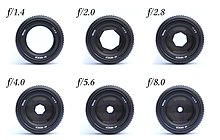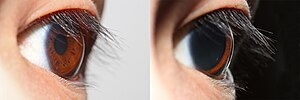
Back Lensopening Afrikaans بؤرة (كاميرا) Arabic Apertur Azerbaijani Апертура (оптыка) Byelorussian উন্মেষ Bengali/Bangla Obertura (diafragma) Catalan Blende (Optik) German Apertura Spanish Ava (fotograafia) Estonian Irekidura (argazkigintza) Basque





In optics, the aperture of an optical system (including a system consisted of a single lens) is a hole or an opening that primarily limits light propagated through the system. More specifically, the entrance pupil as the front side image of the aperture and focal length of an optical system determine the cone angle of a bundle of rays that comes to a focus in the image plane.
An optical system typically has many openings or structures that limit ray bundles (ray bundles are also known as pencils of light). These structures may be the edge of a lens or mirror, or a ring or other fixture that holds an optical element in place or may be a special element such as a diaphragm placed in the optical path to limit the light admitted by the system. In general, these structures are called stops,[2] and the aperture stop is the stop that primarily determines the cone of rays that an optical system accepts (see entrance pupil). As a result, it also determines the ray cone angle and brightness at the image point (see exit pupil). The aperture stop generally depends on the object point location; on-axis object points at different object planes may have different aperture stops, and even object points at different lateral locations at the same object plane may have different aperture stops (vignetted).[3] In practice, many object systems are designed to have a single aperture stop at designed working distance and field of view.
In some contexts, especially in photography and astronomy, aperture refers to the opening diameter of the aperture stop through which light can pass. For example, in a telescope, the aperture stop is typically the edges of the objective lens or mirror (or of the mount that holds it). One then speaks of a telescope as having, for example, a 100-centimetre (39 in) aperture. The aperture stop is not necessarily the smallest stop in the system. Magnification and demagnification by lenses and other elements can cause a relatively large stop to be the aperture stop for the system. In astrophotography, the aperture may be given as a linear measure (for example, in inches or millimetres) or as the dimensionless ratio between that measure and the focal length. In other photography, it is usually given as a ratio.
A usual expectation is that the term aperture refers to the opening of the aperture stop, but in reality, the term aperture and the aperture stop are mixed in use. Sometimes even stops that are not the aperture stop of an optical system are also called apertures. Contexts need to clarify these terms.
The word aperture is also used in other contexts to indicate a system which blocks off light outside a certain region. In astronomy, for example, a photometric aperture around a star usually corresponds to a circular window around the image of a star within which the light intensity is assumed.[4]
- ^ Thomas Blount, Glossographia Anglicana Nova: Or, A Dictionary, Interpreting Such Hard Words of whatever Language, as are at present used in the English Tongue, with their Etymologies, Definitions, &c. Also, The Terms of Divinity, Law, Physick, Mathematics, History, Agriculture, Logick, Metaphysicks, Grammar, Poetry, Musick, Heraldry, Architecture, Painting, War, and all other Arts and Sciences are herein explain'd, from the best Modern Authors, as, Sir Isaac Newton, Dr. Harris, Dr. Gregory, Mr. Lock, Mr. Evelyn, Mr. Dryden, Mr. Blunt, &c., London, 1707.
- ^ "Exposure Stops in Photography - A Beginner's Guide". Photography Life. 16 January 2015. Retrieved 10 May 2019.
- ^ Hecht, Eugene (2017). "5.3.2 Entrance and Exit Pupils". Optics (5th ed.). Pearson. ISBN 978-1-292-09693-3.
- ^ Nicholas Eaton, Peter W. Draper & Alasdair Allan, Techniques of aperture photometry Archived 11 March 2007 at the Wayback Machine in PHOTOM – A Photometry Package, 20 August 2002
© MMXXIII Rich X Search. We shall prevail. All rights reserved. Rich X Search